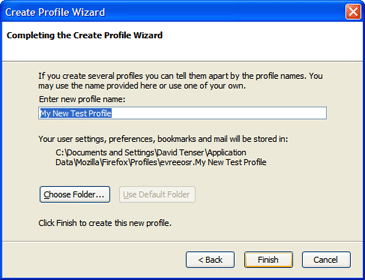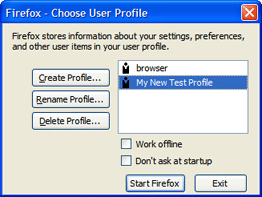Thunderbird/support/profile
Mozilla Thunderbird stores all your personal settings, such as your mail, passwords and extensions, in a profile. The profile is stored on your hard drive in a profile folder.
If you run into problems using Thunderbird (e.g. problems starting after installing an extension, or other features not functioning properly), the first thing you're usually asked to do in the tech support forum is to create a new profile. This tutorial will not only show you how to do that, but also how to create backups and move or restore existing profiles.
Contents
Locate your profile folder
Knowing where your profile folder is stored can be useful if, for example, you want to make a backup of your personal data.
- On Windows Vista/XP/2000, the path is usually
%AppData%\Thunderbird\Profiles\xxxxxxxx.default\, where xxxxxxxx is a random string of 8 characters. Just browse toC:\Documents and Settings\[User Name]\Application Data\Thunderbird\Profiles\on Windows XP/2000 orC:\users\[User Name]\AppData\Roaming\Thunderbird\Profiles\on Windows Vista, and the rest should be obvious. - On Windows 95/98/Me, the path is usually
C:\WINDOWS\Application Data\Mozilla\Thunderbird\Profiles\xxxxxxxx.default\ - On Linux, the path is usually
~/.thunderbird/xxxxxxxx.default/ - On Mac OS X, the path is usually
~/Library/Thunderbird/Profiles/xxxxxxxx.default/
%AppData% is a shorthand for the Application Data path on Windows 2000/XP/Vista. To use it, click Start > Run... (use the search box on Vista), enter %AppData% and press Enter. You will be taken to the "real" folder, which is normally C:\Documents and Settings\[User Name]\Application Data on Windows XP/2000, C:\users\[User Name]\AppData\Roaming on Windows Vista.
Create a new profile
The screenshots are from Firefox, but the appearance is the same in Thunderbird. In order to create a new profile, you use the Profile Manager. To start the Profile Manager in Windows, follow these steps:
- Close Thunderbird completely (select File > Exit from the main menu of Thunderbird).
- Select Start > Run... from the Windows Start menu (use the search box on Vista).
- Enter
thunderbird.exe -ProfileManagerand press .
On Mac OS X, navigate to /Applications/Utilities, open the Terminal application, type
/Applications/Thunderbird.app/Contents/MacOS/thunderbird-bin -ProfileManager, and press Return.
On Linux, start Thunderbird with the -profilemanager switch, e.g. ./thunderbird -ProfileManager (this assumes that you're in the Thunderbird directory).
You should now see the Profile Manager window, shown in the screenshot to the right.
From the Profile Manager you are also able to remove and rename profiles.
Click on the button to start the Create Profile Wizard. Click and enter the name of the profile, e.g. your name or something descriptive.
You can also choose where on the disk you want the profile to be stored, which is useful if you plan on exporting your settings to another computer or setup in the future.
Finally, click to have Thunderbird create the new profile.
You should now be taken back to the Profile Manager and the newly created profile should be listed. Select it and click . That's it! You are now running Thunderbird with the new profile, which means all settings are reset to default. If you want to switch back to your old profile, just start the Profile Manager again (instructions above) and select the old profile.
You can also have Thunderbird start a selected profile automatically, so you don't have to pick one each time the browser is launched. Do this by checking the Don't ask at startup option.
Backing up your profile
Backing up your profile folder in Thunderbird is easy. Just follow these steps (which assumes you know how to manage files on your computer):
- Shut down Thunderbird completely (File > Exit).
- Make a copy of your profile folder to, for example, a CD-RW disc or a separate hard disk for backup purposes.
Move an existing profile or restore a backed up profile
It's possible to move the location of a profile folder. This could be useful if you have a backed up profile folder somewhere on your hard drive and want to tell Thunderbird to use that as your profile. This section explains how to do this.
- Shut down Thunderbird completely (File > Exit).
- Move the profile folder to the desired location. For example, on Windows XP, move the profile from
C:\Documents and Settings\[username]\Application Data\Thunderbird\Profiles\xxxxxxxx.defaulttoD:\Stuff\MyMailProfile. If you are reading these instructions because you want to restore a previously backed up profile, this step isn't necessary. Just note the current location of the profile you want to restore. - Open up
profiles.iniin a text editor. The file is located in the application data folder for Thunderbird:- On Windows Vista/XP/2000, the path is
%AppData%\Thunderbird\ - On Windows 95/98/Me, the path is usually
C:\WINDOWS\Application Data\Thunderbird\ - On Linux, the path is
~/.thunderbird/ - On Mac OS X, the path is
~/Library/Thunderbird/
- On Windows Vista/XP/2000, the path is
- In
profiles.ini, locate the entry for the profile you've just moved. Change thePath=line to the new location. IMPORTANT NOTICE: If you switch from a relative path to a non-relative one, the direction of the slashes may need to change (e.g. in Windows, non-relative paths use backslashes, whereas relative ones use forward slashes). - Change
IsRelative=1toIsRelative=0. - Save
profiles.iniand restart Thunderbird.


